Taoniinae
Richard E. Young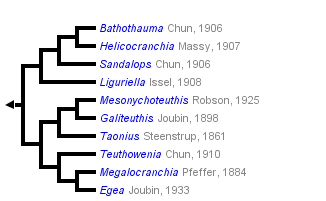


This tree diagram shows the relationships between several groups of organisms.
The root of the current tree connects the organisms featured in this tree to their containing group and the rest of the Tree of Life. The basal branching point in the tree represents the ancestor of the other groups in the tree. This ancestor diversified over time into several descendent subgroups, which are represented as internal nodes and terminal taxa to the right.

You can click on the root to travel down the Tree of Life all the way to the root of all Life, and you can click on the names of descendent subgroups to travel up the Tree of Life all the way to individual species.
For more information on ToL tree formatting, please see Interpreting the Tree or Classification. To learn more about phylogenetic trees, please visit our Phylogenetic Biology pages.
close boxIntroduction
The Taoniinae is much more diverse in genera and species than the Cranchiinae.
Brief diagnosis:
A cranchiid ...
- without cartilagenous tubercules on mantle except, occasionally, at funnel and nuchal locking points.
- with one to three photophores of very different sizes and shapes on eyes.
Characteristics
- Arms
- Arms IV not hectocotylized in males.
- Arms IV not hectocotylized in males.
- Head
- Eyes on stalks in paralarvae and in some juveniles.
 Click on an image to view larger version & data in a new window
Click on an image to view larger version & data in a new window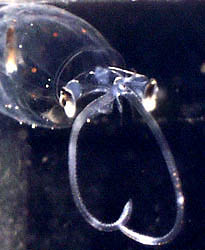
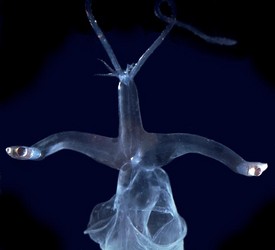
Figure. Paralarvae of Megalocranchia fisheri (left, anterolateral view) and Bathothauma lyromma (right, dorsal view), Hawaiian waters. Stalked eyes in which the eye and optic lobe are separated from the brain by a long optic stalk, is unique to the Cranchiidae and are present in young stages of virtually all taoniins. Photographs by R. Young.
- Eyes on stalks in paralarvae and in some juveniles.
- Funnel
- Funnel not fused to head laterally.
- Funnel not fused to head laterally.
- Mantle.
- Cartilagenous strips on mantle absent. Cartilagenous tubercules, when present, occur only where the mantle is fused to the head and funnel at the funnel and nuchal locking-points.
- Cartilagenous strips on mantle absent. Cartilagenous tubercules, when present, occur only where the mantle is fused to the head and funnel at the funnel and nuchal locking-points.
- Photophores
- Eyes with one to three (most commonly two) photophores of very different sizes and shapes.
 Click on an image to view larger version & data in a new window
Click on an image to view larger version & data in a new window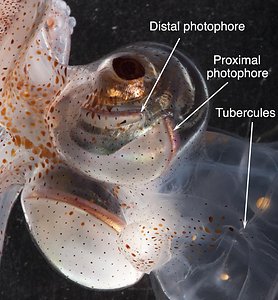
Figure. Ventrolateral view of the head and funnel of Taonius borealis, showing (1) the most common photophore arrangement of ocular photophores in the Taoniinae and (2) the two small tubercules the mantle is fused to the funnel. Each photophore is composed of two components, a golden-colored region bearing the photogenetic material, and a white region composed of light guides to distribute the light over the eyeball. Also note . Photograph by H-J Hoving.
- Eyes with one to three (most commonly two) photophores of very different sizes and shapes.
- Viscera
- Stomach larger than caecum.
Comparison of genera (blank cell = N)
| Fins small, separate, paddle-like | Short, lanceolate fins inserting on broadest point on gladius | Moderate, lanceolate fins inserting on mantle | Long, lanceolate, terminal fins | Funnel valve | Tubercules at funnel-mantle fusion | Tubular eyes in juveniles | Hooks or hook-like suckers on clubs | Three photo-phores on eyeball | Photo-phores on viscera | Suckers on tentacle stalk in 4 series. Distally only* | |
| Bathothauma | Y | Y* | |||||||||
|---|---|---|---|---|---|---|---|---|---|---|---|
| Helicocranchia | Y | ||||||||||
| Sandalops | Y | Y | |||||||||
| Liguriella | Y | Y | |||||||||
| Mesonychoteuthis | Y/N | Y | |||||||||
| Galiteuthis | Y | Y/N | Y | ||||||||
| Taonius | Y | * | Y | Y | |||||||
| Teuthowenia | Y | Y | Y | Y | |||||||
| Megalocranchia | Y | Y | Y* | ||||||||
| Egea | Y | Y |
Title Illustrations

| Scientific Name | Galiteuthis armata |
|---|---|
| Location | Central North Atlantic |
| Acknowledgements | Photograph taken on the MarEco cruise of the R/V G.O. SARS |
| Specimen Condition | Live Specimen |
| View | Side |
| Size | 240 mm ML |
| Image Use |
 This media file is licensed under the Creative Commons Attribution-NonCommercial License - Version 3.0. This media file is licensed under the Creative Commons Attribution-NonCommercial License - Version 3.0.
|
| Copyright |
© 2004

|
About This Page

University of Hawaii, Honolulu, HI, USA
Correspondence regarding this page should be directed to Richard E. Young at
Page copyright © 2019
 Page: Tree of Life
Taoniinae .
Authored by
Richard E. Young.
The TEXT of this page is licensed under the
Creative Commons Attribution-NonCommercial License - Version 3.0. Note that images and other media
featured on this page are each governed by their own license, and they may or may not be available
for reuse. Click on an image or a media link to access the media data window, which provides the
relevant licensing information. For the general terms and conditions of ToL material reuse and
redistribution, please see the Tree of Life Copyright
Policies.
Page: Tree of Life
Taoniinae .
Authored by
Richard E. Young.
The TEXT of this page is licensed under the
Creative Commons Attribution-NonCommercial License - Version 3.0. Note that images and other media
featured on this page are each governed by their own license, and they may or may not be available
for reuse. Click on an image or a media link to access the media data window, which provides the
relevant licensing information. For the general terms and conditions of ToL material reuse and
redistribution, please see the Tree of Life Copyright
Policies.
- First online 17 September 2004
- Content changed 27 February 2016
Citing this page:
Young, Richard E. 2016. Taoniinae . Version 27 February 2016 (under construction). http://tolweb.org/Taoniinae/19545/2016.02.27 in The Tree of Life Web Project, http://tolweb.org/




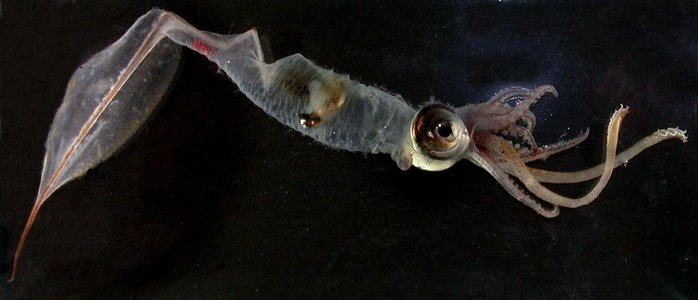


 Go to quick links
Go to quick search
Go to navigation for this section of the ToL site
Go to detailed links for the ToL site
Go to quick links
Go to quick search
Go to navigation for this section of the ToL site
Go to detailed links for the ToL site